Dinosaurs were a diverse group of reptiles that dominated Earth’s landscapes during the Mesozoic Era, lasting over 165 million years. Their fossilized remains reveal fascinating insights into their biology, behavior, and evolution. From small, feathered creatures to massive sauropods, dinosaurs showcased incredible diversity. Their study has captivated scientists and the public alike, offering a window into Earth’s prehistoric past.
1.1 Definition and Overview
Dinosaurs were a group of reptiles that dominated Earth’s landscapes during the Mesozoic Era, spanning over 165 million years. They were characterized by their upright limb posture and scaly skin. Dinosaurs varied greatly in size, from small, feathered creatures to massive sauropods. Their fossilized remains, including bones, eggs, and tracks, provide vital insights into their biology and evolution. The term “Dinosauria” was coined by Sir Richard Owen in 1842, derived from the Greek words deinos (terrible) and sauros (lizard). Despite their diversity, all non-avian dinosaurs went extinct 66 million years ago, marking the end of the Cretaceous period.
1.2 Historical Significance and Fascination
Dinosaurs have captivated human imagination for centuries, inspiring scientific inquiry and cultural fascination. Their fossils, first discovered in ancient times, sparked myths of giant creatures and dragons. The formal study of dinosaurs began in the 19th century, revolutionizing paleontology and our understanding of Earth’s history. Dinosaurs represent a bridge to the prehistoric past, offering insights into evolution and life’s diversity. Their allure extends beyond science, influencing art, literature, and popular media. From children’s books to documentaries, dinosaurs remain a timeless symbol of wonder, connecting us to a world that once was, yet continues to inspire and educate generations.
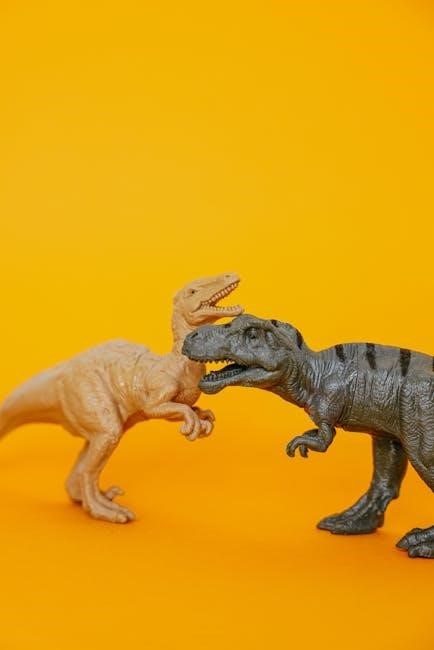
Classification of Dinosaurs
Dinosaurs are classified into two main groups: Saurischians (lizard-hipped) and Ornithischians (bird-hipped), based on their hip bone structure. This classification helps in understanding their evolutionary differences.
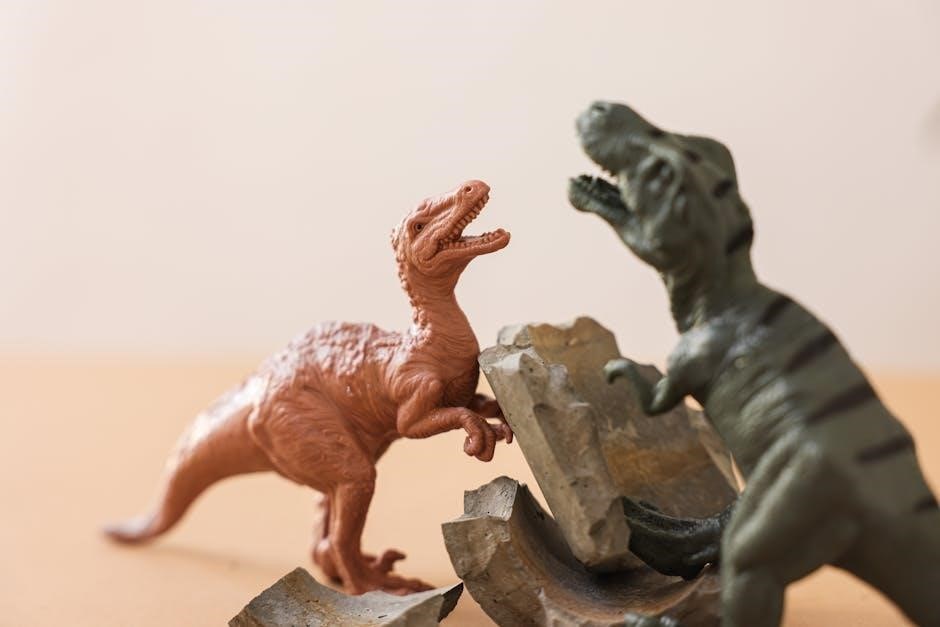
2.1 Saurischian Dinosaurs (Lizard-Hipped)
Saurischian dinosaurs, characterized by their lizard-like hip structure, were a diverse group that dominated the Mesozoic Era. This group includes both herbivorous and carnivorous species, such as sauropods and theropods. Sauropods, like Brachiosaurus, were massive, long-necked herbivores, while theropods, including Tyrannosaurus rex, were primarily meat-eaters. Saurischians were highly adaptable, with varying body sizes and specialized features. Their hip bones, with a pubis pointing downward, distinguished them from ornithischians. This classification highlights their evolutionary significance, as theropods are closely linked to modern birds. Saurischians played a pivotal role in shaping the prehistoric ecosystems they inhabited.
2.2 Ornithischian Dinosaurs (Bird-Hipped)
Ornithischian dinosaurs, named for their bird-like hip structure, were primarily herbivorous and diverse in form. This group includes armored dinosaurs like Stegosaurus and Ankylosaurus, as well as horned dinosaurs such as Triceratops. Their hips featured a backward-pointing pubis, parallel to the ischium, distinguishing them from saurischians. Many ornithischians had specialized adaptations, such as bony plates, spikes, or horns, likely for defense or display. Despite their varied sizes and body armor, they shared a common herbivorous diet and played a significant role in shaping prehistoric ecosystems. Their unique characteristics continue to intrigue paleontologists and dinosaur enthusiasts alike.
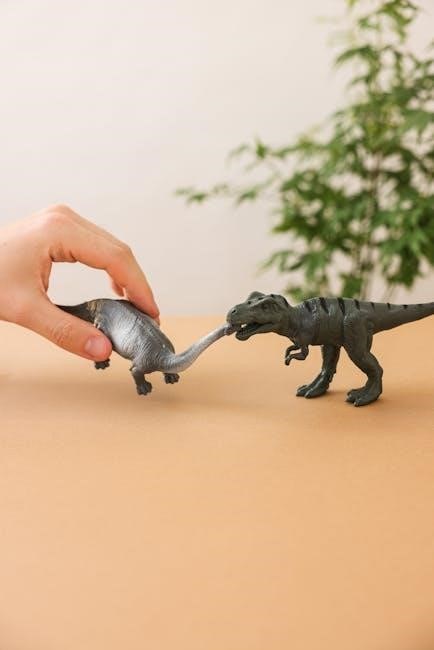
Major Types of Dinosaurs
Dinosaurs were broadly categorized into herbivorous and carnivorous types, showcasing remarkable diversity in size, form, and adaptations. Herbivores like sauropods and hadrosaurs dominated plant-eating niches, while carnivores, including theropods, were formidable predators. This classification reflects their ecological roles and dietary specializations, highlighting the complexity of prehistoric life.
3.1 Herbivorous Dinosaurs
Herbivorous dinosaurs, such as sauropods and hadrosaurs, were plant-eaters that played a vital role in shaping ancient ecosystems. Sauropods, like Brachiosaurus, were massive, long-necked herbivores that roamed in herds, feeding on high vegetation. Stegosaurus, with its bony plates, and Ankylosaurus, armored for defense, were slower-moving herbivores adapted to protecting themselves from predators. Ceratopsians, like Triceratops, had distinctive frills and horns, likely used for display and defense. These herbivores varied greatly in size and adaptation, from small, agile forms to giant, lumbering species, showcasing the diversity of plant-eating dinosaurs during the Mesozoic Era.
3.2 Carnivorous Dinosaurs
Carnivorous dinosaurs, such as Tyrannosaurus rex and Velociraptor, were formidable predators adapted for hunting and meat consumption. Tyrannosaurus rex, one of the largest carnivores, had a powerful bite force and was likely an apex predator. Velociraptors were smaller but highly intelligent pack hunters, using sharp claws for lethal attacks. Oviraptor, once mistaken for an egg-eater, is now believed to have been feathered and possibly omnivorous. These predators played a crucial role in maintaining ecological balance, their diverse hunting strategies reflecting the complexity of dinosaur evolution and their dominance during the Mesozoic Era.
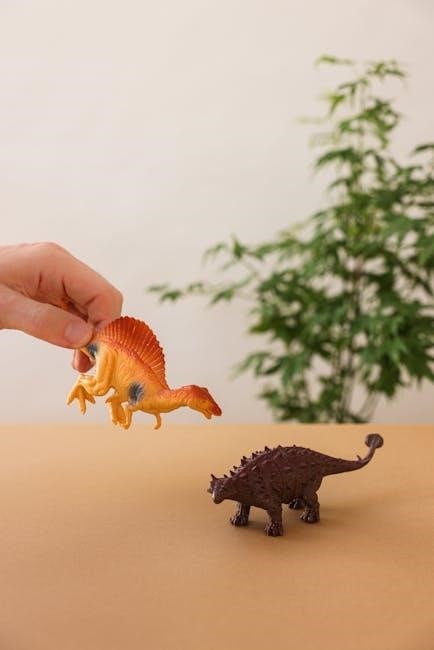
Dinosaur Behavior
Dinosaurs exhibited complex behaviors, including nesting, social interactions, and parental care. Maiasaura, a herbivore, showed evidence of nurturing young, while carnivores like Velociraptor likely hunted in packs, displaying intelligent strategies. These behaviors highlight their adaptability and social structures, providing insights into their biology and energetic lifestyles.
4.1 Diet and Feeding Habits
Dinosaurs exhibited diverse feeding behaviors, with herbivores dominating in number. Sauropods used their long necks and tails to gather vegetation, while hadrosaurs employed specialized beaks to process tough plants. Carnivorous dinosaurs, like Tyrannosaurus Rex, relied on powerful bites and pack hunting to consume prey. Some smaller carnivores likely scavenged or hunted in groups. Herbivores like Stegosaurus and Ankylosaurus had defensive mechanisms to deter predators. Fossil evidence, including bite marks and digestive contents, reveals their feeding strategies, showcasing their adaptability to various ecological roles during the Mesozoic Era. These habits highlight their crucial role in shaping ancient ecosystems.
4.2 Social Behavior and Interaction
Dinosaurs exhibited varied social behaviors, with evidence suggesting group living and interaction. Many herbivorous species, like hadrosaurs and ceratopsians, likely formed herds for protection. Trackways and nesting sites indicate communal behavior, such as shared nesting grounds. Some carnivores, including smaller theropods, may have hunted cooperatively. Display structures, like the frills of ceratopsians, suggest roles in communication or mate attraction. Fossilized footprints and herd behaviors highlight their social complexity. These interactions were crucial for survival, reflecting adaptability to their environments and ecological roles during the Mesozoic Era. Such behaviors emphasize their dynamic presence in prehistoric ecosystems.
4.3 Nesting and Care of Young
Dinosaurs exhibited complex nesting behaviors, with evidence of parental care. Many species, like Maiasaura, built nests and incubated eggs. Fossilized nests often contain eggs arranged in specific patterns, suggesting intentional organization. Vegetation was sometimes used to regulate nest temperature, indicating resourcefulness. Adult dinosaurs likely guarded their nests, as fossils of adults near nests have been found. Juvenile dinosaurs often remained in nesting areas post-hatching, implying extended care. These behaviors highlight a level of parental investment uncommon among reptiles, offering insights into dinosaur social and reproductive strategies. Such care likely improved offspring survival, contributing to their evolutionary success during the Mesozoic Era.
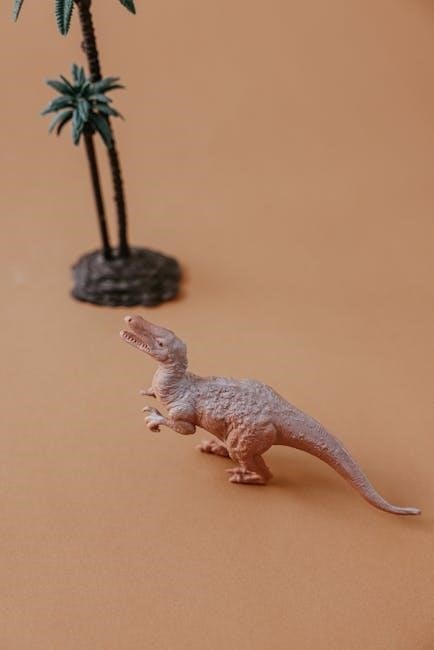
The Extinction of Dinosaurs
Dinosaurs went extinct 66 million years ago, likely due to a massive asteroid impact and volcanic activity. This event marked the end of the Cretaceous period.
5.1 Theories of Mass Extinction
The extinction of dinosaurs is linked to multiple theories, with the most widely accepted being the asteroid impact hypothesis. A massive asteroid collision caused global firestorms, tsunamis, and a “nuclear winter,” blocking sunlight and halting photosynthesis. Volcanic eruptions in India, known as the Deccan Traps, also released toxic gases, exacerbating environmental stress. Other theories include sea-level changes, climate shifts, and disease outbreaks. While debates persist, the asteroid impact combined with volcanic activity is the leading explanation for the Cretaceous-Paleogene extinction event that wiped out non-avian dinosaurs 66 million years ago.
5.2 Impact of Volcanic Activity and Asteroid Collisions
The mass extinction of dinosaurs is closely tied to catastrophic events, including massive volcanic eruptions and an asteroid collision. Volcanic activity, such as the Deccan Traps in India, released vast amounts of toxic gases, causing climate disruption and acid rain. Simultaneously, the Chicxulub asteroid impact triggered global firestorms, a “nuclear winter,” and a dramatic drop in sunlight. These events devastated ecosystems, leading to the collapse of food chains. The combination of volcanic and asteroid impacts created an environmental crisis, ultimately resulting in the extinction of non-avian dinosaurs and marking the end of the Cretaceous period.
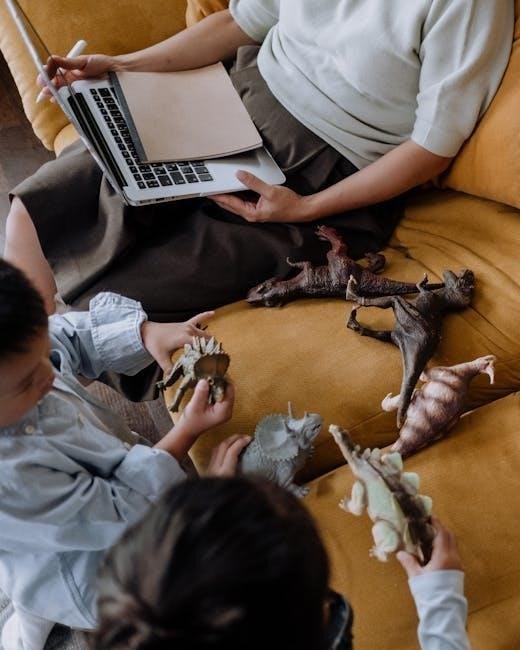
Dinosaur Fossils and Their Importance
Dinosaur fossils provide critical insights into their biology, behavior, and evolution. Bones, eggs, and tracks reveal their diversity, growth patterns, and environmental interactions, shaping our understanding of prehistoric life.
6.1 Fossil Discovery and Analysis
Dinosaur fossils have been discovered on all seven continents, providing valuable insights into their biology and behavior. These fossils include bones, teeth, eggs, and even skin impressions. Advanced technologies like CT scans and 3D modeling help analyze these remains, revealing details about growth patterns, diet, and movement. Fossilized tracks and nests offer clues about social interactions and reproductive habits. The study of these fossils has significantly contributed to understanding dinosaur evolution and extinction events, making them a cornerstone of paleontological research and education.
6.2 Fossilized Eggs, Nests, and Tracks
Fossilized dinosaur eggs, nests, and tracks provide unique insights into their reproductive and social behaviors. Many nests, like those of Maiasaura, show evidence of parental care, with eggs arranged in circular patterns. Tracks reveal locomotion patterns, herd behavior, and even interactions between species. For instance, Oviraptor nests demonstrate brooding behaviors, while massive sauropod trackways suggest migratory herds. These fossils are invaluable for reconstructing dinosaur ecology, offering glimpses into their daily lives and social structures. Such discoveries continue to captivate researchers and the public, enriching our understanding of these prehistoric creatures.
Modern Discoveries and Research
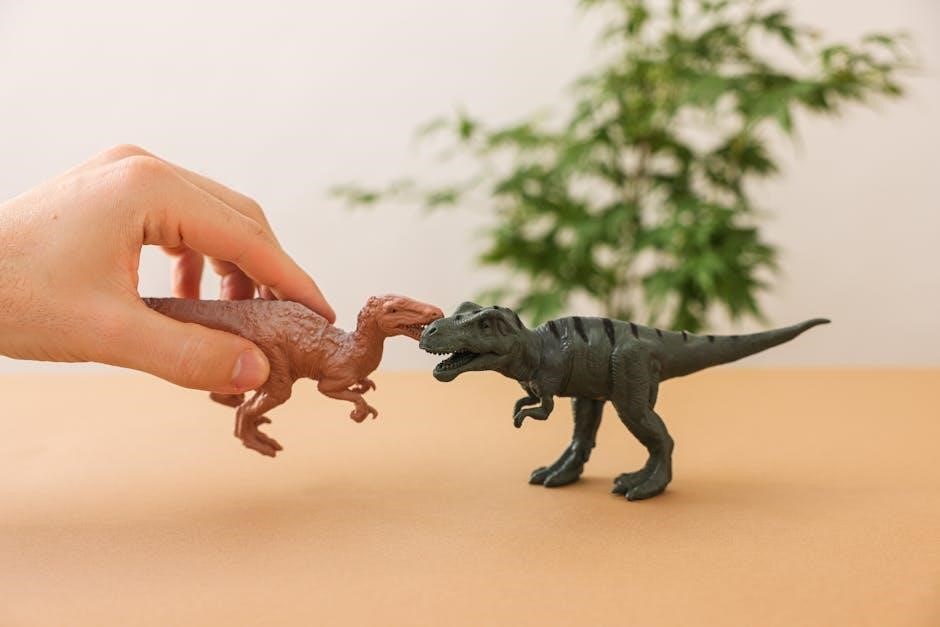
Modern research reveals feathered dinosaurs’ links to birds, with fossils showing quill knobs for feather attachment. Advanced imaging techniques uncover new insights into dinosaur anatomy and behavior.
7.1 Advances in Paleontological Studies
Paleontological studies have advanced significantly, revealing intricate details about dinosaur biology. Modern technologies like CT scanning and 3D modeling enable researchers to analyze fossils non-invasively. Feathered dinosaur discoveries in China have provided evidence of their link to modern birds. Additionally, isotopic analysis offers insights into dinosaur diets and metabolisms, suggesting some species were warm-blooded. These findings challenge traditional views and deepen our understanding of dinosaur evolution, behavior, and diversity. Such advancements continue to reshape the field, offering a more comprehensive view of these prehistoric creatures and their role in Earth’s history.
7.2 Feathered Dinosaurs and Their Link to Birds
The discovery of feathered dinosaurs in China has revolutionized our understanding of their connection to modern birds. Fossils like Sinosauropteryx and Microraptor reveal intricate feather structures, suggesting many theropods were feathered. These findings support the theory that birds evolved directly from theropod dinosaurs. Feathers likely served multiple purposes, including insulation, display, and flight. The presence of quill knobs on fossils indicates where feathers attached, further linking dinosaurs to avian anatomy. This evidence underscores a seamless evolutionary transition, blurring the line between non-avian dinosaurs and their feathered, flying descendants.
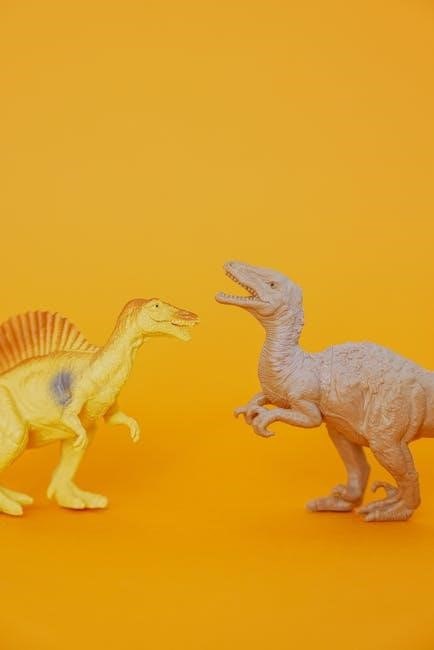
Educational Resources on Dinosaurs
Explore dinosaur learning with books like How Do Dinosaurs… series and The Story of Dinosaurs PDF guides. Interactive tools, quizzes, and coloring pages enhance educational engagement for all ages;
8.1 Recommended Books and PDF Guides
Discover the fascinating world of dinosaurs through comprehensive books and PDF guides. The Story of Dinosaurs by Dr. Ashley Burkett offers a detailed, free resource for students. The How Do Dinosaurs… series by Jane Yolen and Mark Teague engages young readers with whimsical stories. For in-depth knowledge, the World Encyclopedia of Dinosaurs & Prehistoric Creatures features over 1,000 species with stunning visuals. PDF guides like Dinosaurs: The Ultimate Visual Reference provide insights into dinosaur anatomy, evolution, and behavior. These resources are perfect for both enthusiasts and researchers, offering a wealth of information in accessible formats.
8.2 Interactive Learning Tools and Activities
Engage with dinosaurs through interactive tools and activities that bring prehistoric life to the present. Dinosaur-themed coloring pages, quizzes, and games offer fun ways to learn about these creatures. Virtual fossil digs and 3D simulations allow exploration of dinosaur anatomy and habitats. Interactive PDF guides, such as those featuring dinosaur size comparisons or evolutionary timelines, enhance understanding. Hands-on activities like building dinosaur models or creating timelines encourage creativity and critical thinking. These tools cater to all ages, making learning about dinosaurs an immersive and enjoyable experience for both students and enthusiasts.